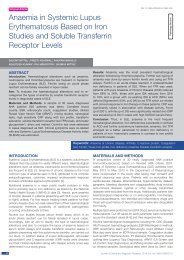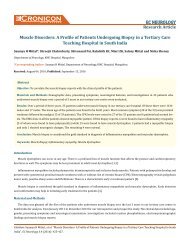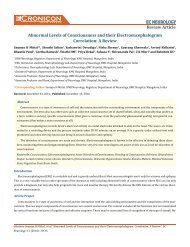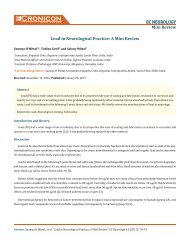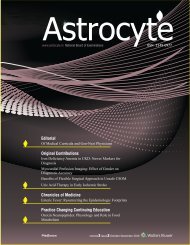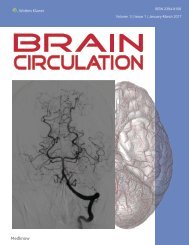Incognizant Cause of Misdiagnosed Seizure
You also want an ePaper? Increase the reach of your titles
YUMPU automatically turns print PDFs into web optimized ePapers that Google loves.
<strong>Incognizant</strong> <strong>Cause</strong> <strong>of</strong> <strong>Misdiagnosed</strong> <strong>Seizure</strong><br />
and therefore unrecognized gratification disorder may result into extensive and expensive workup and wrong initiation <strong>of</strong> treatment with<br />
antiepileptic drugs etc. [4-6].<br />
423<br />
Gratification disorder may be frequently seen in children after age <strong>of</strong> 2 to 3 months. Frequently, these children are deprived <strong>of</strong> tactile<br />
sensory domain. Our patient would stop the movements when picked up by the mother. This may be explained by this phenomenon. The<br />
other cause may be child sexual abuse. Many authors have considered other conditions like sleep disorders, genitourinary irritations, and<br />
even early weaning from breast feeding as a cause [4,6,7].<br />
The patient may show adduction <strong>of</strong> thighs, eidetic imagery, grunting, rocking, sweating and occasionally twitching and pelvic thrusting.<br />
The lack <strong>of</strong> genital stimulation <strong>of</strong>ten confuses the physicians misleading them to diagnose a condition other than infantile masturbation.<br />
It may help the physicians if they consider that torsional posturing, rocking and cessation on distraction is uncommon in seizures.<br />
These children appear annoyed if interrupted. Some children display facial flushing, cyanosis, lip smacking, staring, shaking, pallor, giggling,<br />
and frightened appearance [4,5,7].<br />
It also confuses movement disorder specialists when it resembles paroxysmal dystonic choreoathetosis [4].<br />
This may become a habit when the child is bored or sleepy. No children have been reported to develop seizures subsequently. However,<br />
variations in behavioural manifestations may be noted as the child grows up. An association with ADHD may be noted as the child<br />
grows up. The lack <strong>of</strong> motor and cognitive abilities may preclude manifestation <strong>of</strong> ADHD in infants. Once diagnosed, the parents need<br />
to be counselled and educated about this normal behaviour. They should be informed that this can subside when the child is engaged in<br />
another activity in his environment [4,7].<br />
Conclusion<br />
Misdiagnosis <strong>of</strong> seizure is very common. The main reasons for this are:<br />
1. Most frequently, diagnosis is based on history while the examination may be frequently normal.<br />
2. The differential diagnosis <strong>of</strong> seizures is large and there is no confirmatory test for seizures. Frequently, the basic tests may simply be<br />
unavailable to a treating physician.<br />
3. Physicians may either not have enough knowledge about differentials <strong>of</strong> the seizures, or may be apprehensive about missing a diagnosis<br />
<strong>of</strong> seizures thereby over diagnosing the syndrome [1].<br />
It is important to avoid misdiagnosing or over diagnosing epilepsy. Wrong diagnosis can be detrimental. Many leisure activities, pr<strong>of</strong>essional<br />
or educational prospects may be restricted. Patients are subjected to the side effects <strong>of</strong> the antiepileptic drugs. Correct diagnosis<br />
and treatment are denied, and in many cases patients may not need treatment. Only explaining the condition to patient or parents (like in<br />
our case) and reassurance may be needed [1,3].<br />
In children, the diagnosis <strong>of</strong> seizure should be made by a specialist- a paediatrician trained in the expertise <strong>of</strong> epilepsy [8].<br />
Gratification disorder should be considered as a differential diagnosis in a case suspected with seizures if the episodes develop between<br />
age <strong>of</strong> 3 months and 3 years with aforementioned signs and symptoms, lower limb posturing, normal examination and laboratory<br />
reports.<br />
Citation: Saumya H Mittal., et al. “<strong>Incognizant</strong> <strong>Cause</strong> <strong>of</strong> <strong>Misdiagnosed</strong> <strong>Seizure</strong>”. EC Neurology 3.4 (2016): 422-424.




